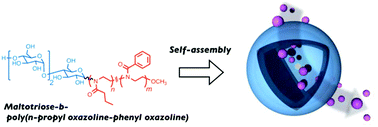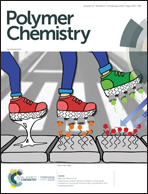Intrinsically permeable polymer vesicles based on carbohydrate-conjugated poly(2-oxazoline)s synthesized using a carbohydrate-based initiator system†
Abstract
Polymer vesicles with molecular permeability offer significant potential to contribute to the understanding of biocatalytic processes in nano/micro compartments and therapeutic enzyme reactors. However, constructing such permeable vesicles remains challenging, as clear guidelines for the design of permeable membranes remain elusive. In the present study we focused on a hydrophobic polymer with hydrogen bond donor and acceptor moieties, i.e., a polymer that exhibits a lower-critical-solution-temperature (LCST)-like behavior, as a suitable component for the permeable bilayer membrane. We have developed a carbohydrate-based initiator system for the cationic ring opening polymerization of 2-oxazoline and synthesized molecular permeable polymer vesicles based on an amphiphilic block polymer composed of maltotriose and poly(n-propyl oxazoline) that exhibit LCST-like behavior. The resulting polymer vesicles are permeable to up to 1 kg mol−1 of FITC-PEG. These findings represent a major milestone toward the development of (i) intrinsically permeable polymer vesicles and (ii) functional polymer vesicles for a broad range of fundamental and biomedical applications.



 Please wait while we load your content...
Please wait while we load your content...